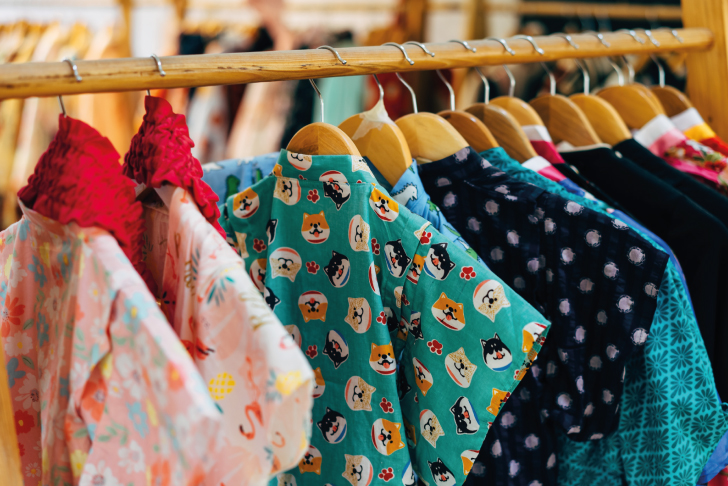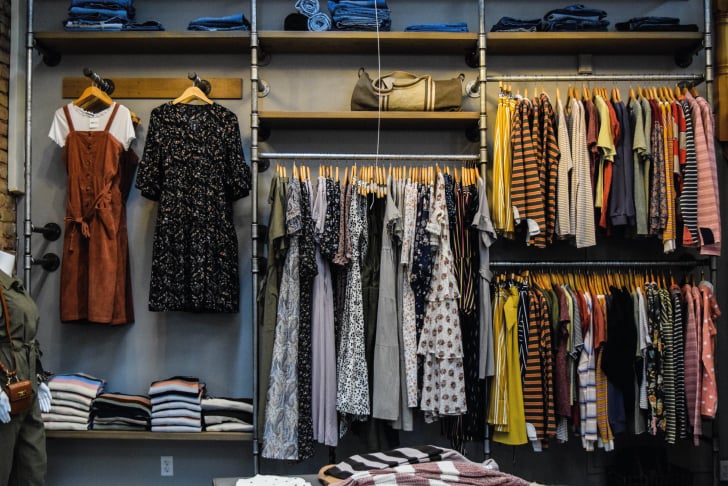Setting Up Your Clothing Line – The Specifics
‘I want to start a clothing line!’ is a moment of personal enlightenment and ambition that needs careful research and business planning to match your initial enthusiasm and ensure that you turn your big idea into a successful business.
How hard is it to start a clothing brand? Being 100% passionate about fashion and design is half the job.
The other half involves writing a business plan, starting a small business, coming up with a marketing plan, making and then selling products, and managing cash flow – to name just a few of the business needs you’ll have to attend to!
Don’t despair, we’re here to walk you through the steps you need to take as a small business owner to start a clothing line and design your own clothing brand.
With a bit of focus on the business development side of things, we’ll help you match your creative enthusiasm for fashion to good business protocol, and you’ll soon be well prepared on how to run a successful clothing business.
Developing your business plan

Starting with a business plan is often the hardest part of making money with your own business. This is because you must take all your creative ideas and put them down on paper.
You do this so that you know where you are going with a business start-up – and, more importantly, how you will know what success looks like when you get there.
The vision for your business is a short sentence or two that succinctly encapsulates your dream. For example, ‘I want to start an online clothing line that is inclusive for all body sizes.’
The mission statement is next. This is how you achieve your vision. ‘By setting up an eCommerce store and working after hours, I will explore the online marketplace of inclusive clothing items in an entrepreneurial manner and work diligently on my clothing business until it is profitable for me to do it full-time.’
You then create a SWOT analysis, where you candidly assess your new business by contrasting the strengths and weaknesses with the opportunities and threats, mapping each category in a quadrant on an A4 piece of paper. This will also begin to prepare you for applying for a business loan, should you need financial assistance to get up and running.
Calculate a realistic timeframe for your start-up
Calculating a realistic timeframe for your start-up involves writing down goals that are SMART (specific, measurable, achievable, realistic, and timely). Knowing how to start a fashion business involves consideration of seasonal trends, for example. You don’t want to launch a bikini range in the middle of winter, so ensuring that your product or service is ready for shoppers at the right time of year is critical!
Register your business

In South Africa, you can register your business via your bank if you have an existing bank account, or through the Biz Portal website.
The type of business entity you register will depend largely on your business structure. If you have an equitable partner, then a proprietorship or limited liability company is best. Being a sole proprietor is the way to go if you’re a single business owner.
A tax attorney or chartered accountant can advise on taxation implications for starting out, i.e., if you have a home-based business and are just getting started with selling a product online and don’t have immediate payroll and employment tax obligations.
Now is the time to settle on cohesive business branding, from your website domain name to your garment label. You need a business name that suggests what type of clothing you offer so that whether you are selling online via an existing eCommerce platform or running a brick-and-mortar shop in a mall, customers will immediately understand your brand.
Related to this would be registering any trademarks you may have, to prevent anyone from copying your ideas, logos, and unique niche market offering further down the line.
The costs involved
Your start-up costs to create clothing items that showcase your brand will depend on whether you are equipped to make samples yourself, and the cost of fabric per metre.
You will need an experienced pattern maker and a ‘CMT’ machinist (which stands for cut, make, and trim) to start a clothing line from scratch.
You can spend anywhere from R1,000 to R10,000 for a complete sample clothing range, depending on the type of garments you are producing.
In South Africa, there is a culture of regular flea markets and inclusive boutique clothing shops in fashion malls that will charge you a basic rail rental and a percentage of turnover for exhibiting your brand. Expect to pay R500 at least as a day trader at a popular weekend market.
The costs of renting or buying a shop, hiring a shop manager and retail assistants will quickly escalate into the hundreds of thousands of Rands as you purchase everything required for shopfitting, from a POS system to rails, hangers, and fitted changing rooms.
It is advised that unless you are experienced in launching a business and are wanting to know how to start a luxury clothing brand with lots of disposable income and an angel investor, you rather follow our steps on how to set up a clothing business by first establishing ‘proof of concept’. Let the market tell you that you’re onto something first.
Find out more: Need funding? Check out our guide on small business grants.
Getting funding to start your business venture.
For starting a business, you do need capital. Setting up even the most modest online shopping site with something as simple as a payment gateway with PayPal verification will require start-up capital.
By now, you are far enough in your plans on how to start a clothing line that you can look for a start-up loan or an angel investment. Access to capital is the main contributing factor to the early demise of small businesses in South Africa. It is imperative to do your research on funding, and you can start that by reading our guide on loans to buy a business.
Business founders often make the mistake of being too proud to ask for financial support, as it then requires taking on board a financial partner to whom they are then accountable and owe money to.
If you’d like to explore different grants available in South Africa, you can read our small business grants guide.
Your pricing structures
Understanding your pricing structures will allow you to assess your clothing brand and how it relates to what the market will expect to pay (retail price) for your garment compared to what it costs to make. What is your CPU (cost-per-unit), and what are your estimated monthly running costs (i.e., phone data, petrol, office rental, etc.)?
Calculate your predicted monthly sales and then subtract your total monthly costs from those to determine if you are close to breaking even.
Your price-per-unit should be competitive – i.e., what’s the competition selling at? You should also have a wholesale price if you’re offering your fashion range to independent retailers so that they can put on a mark-up (with a recommended retail price), and a similarly priced retail price if you have your own eCommerce store and are selling direct to customers yourself.
Adhere to clothing line regulations
Adhere to clothing line regulations by including the appropriate wash care labels in your garment. In South Africa, unless you are importing or exporting your garments and require affiliated licenses and permits, you don’t have any licensing requirements to fulfil, other than proving that you are a registered business entity with an identification number that relates to the date your business operations began.
The Design and Manufacturing Process

Sourcing from manufacturers
When it comes to sourcing fabric, items like zips and buttons, or even complete garments, a garment technical pack is required for manufacturers to understand what it is that you need. This lists in exact detail all the garment’s physical components, as well as detailing how it gets made up.
If you’re importing fabric or finished garments, countries closer to home with established textile industries such as Mauritius are often more cost-effective than, say, China, as they form part of the SADC (South African Development Community).
You’ll then need to apply to the International Trade Administration Commission (ITAC) for an import and/or export permit.
More generic garments such as T-shirts or hoodies will allow you to offer wholesale customization, offering customers to print their own team or corporate logo on your ‘blank’ garment.
Direct to garment printing is now becoming increasingly cost-effective, bypassing the traditional screen-printing process that is synonymous with basic fashion items such as printed T-shirts. These allow you to offer bespoke, ‘one-off’ prints and make up to order, saving you stockpiling merchandise in different sizing that will eat away at your cash flow.
Marketing Your Clothing Line
Establishing your brand identity
Establishing your brand identity is a challenging, but fun part of running a successful clothing business. What is your unique selling proposition (USP) that will make your brand stand out from the crowd?
Once you have produced an affordable, reliable fashion item that you are proud of as a business owner, you should return to your brand’s identity and firm up your initial ideas to match the product.
Here you sign off on garment labels, swing tags, and logos that you may register as trademarks, as well as colour palettes and fonts that you will use in your marketing. This is the beginning of your ‘brand bible’ – creating a document that you can refer any freelance designer or manufacturer to. This tells people who and what you are as a clothing brand, while reminding you too.
The importance of an online (and offline) presence for a clothing line
Having a strong online presence for your clothing line – even if you intend on buying second-hand clothing from charity stores and then marketing it as vintage clothing and selling on Amazon as a side business – is important if you want to get your brand into other people’s shopping carts as a viable eCommerce business.
Start by working with a local web developer who can build you a website using eCommerce software that is easy to update as your online sales increase and you look to improve your shopping experience. SquareSpace, Wix, and Wordpress are all good examples.
To set up a customizable website should cost you around R10,000, and you’ll pay a bit more for search engine optimization and customizable features that increase your rate of sales conversions from ‘just browsing’ to payment gateway fulfilment.
Again, having a website builder you can contact easily in the event of a crash is crucial, as the plug-in and extension updates for your online site can prove tricky to manage on your own.
List your products in online fashion marketplaces and do deals to clear dead stock this way. South Africa has a plethora of online clothing websites, such as Takealot and Superbalist. Facebook Marketplace is another free option, should you be selling from home.
'Kamers/Makers' is an example of a national trade show that will quickly tell you if your product is market ready. There are many cultural festivals (KKNK, National Arts Festival in Makhanda, and Hartenbos – to name a few) that have vibrant clothing and food markets attached to theatre and festival events.
If you’re figuring out how to start an online clothing business from home and can afford the time and energy to attend a nearby festival, then renting out a small 3m X 3m stall space and loading your clothing range in your car is a great way to get instant market feedback.
Social media is your clothing brand’s new best friend. Start an Instagram account that links to Facebook, and find innovative ways to post videos of someone modelling your clothing range on TikTok to build up followers.
The bonus is that social media is free, so you just need to devote some time in the evenings to post daily updates and share your brand journey with all your followers. Follow other people in your industry to gain more traction and brand recognition.
Find out more: Need more advice on this sector? Read our sector-specific articles.
Conclusion

These are just a few tips for starting a clothing brand and of course, it’s not as simple as saying ‘I want to make my own clothing brand’ and the next thing you’re selling nationwide. Launching a local clothing start-up in a highly competitive global market takes time, effort, finance, sweat, and tears.
Other fashionistas and clothing entrepreneurs have walked this road already, with some South African businesses up for grabs that may be more to your liking than doing all the paperwork and legwork yourself from the start.
It’s not for the fainthearted, and there are some existing clothing businesses for sale that have done a lot of the hard yards for you. This might be more of an appealing offer to you if you’re wanting an established brand to inject some of your own enthusiasm and business expertise into.
Read this guide on buying a business in South Africa that provides a solid overview of what to look out for, and the benefits of buying an existing business.
Feel free to connect with us should you require any assistance, support, or guidance. Good luck on your journey into the world of South African clothing!
